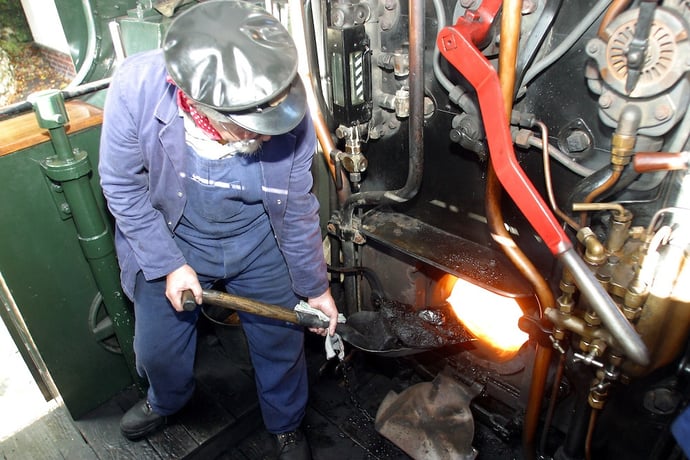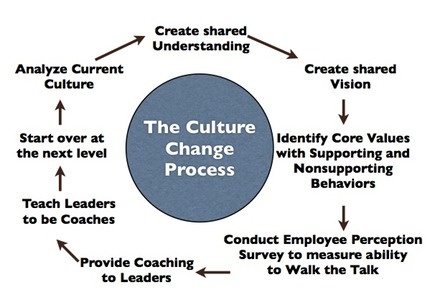Everyone wants to be on board that process improvement train, but no one wants to shovel the coal to get it moving.

Process Improvement is difficult to achieve in any organisation because it requires company-wide buy in and a lot of 'coal shovelers'.
If your goal is improvement, rather than being daunted by the task of 'shoveling coal', changing a work culture and testing the processes in your company, it's important to remember one thing:
The first process improvement steps require an awareness that things need to change and a commitment to seeing change through to the end - which brings us to:
1. The Willingness to change
Guess what? Change isn't easy. Not only does it take willpower on the 'improvers' behalf to achieve, but humans (for whatever reason) hate change - Galileo knows all about that.
You are going to be the one fighting on the front lines of organisational change which means that the job isn't going to be a nap in a bed of roses, or even on a bed of woodchips. You're going to need to convince others, convince yourself and become a 'process improvement preacher'.

Image sourced from: data:image/jpeg;base64
2. Show the benefits of change
No one's ever going to get inspired by a three-hour lecture on 'our business processes and how they can be improved' unless it's being delivered by a resurrected Steve Jobs - don't just tell people how processes can be improved, show them how they can be improved.
3. Show the negatives involved with not implementing process improvement
Some people only need to be told about the joys of heaven to be converted, others need to be reminded about the dangers of hell to jump on the bandwagon.

Image sourced from: coubsecure-s.akamaihd.net
Explain to them that without a process improvement focus, your organisation is in danger of going backwards, suffering quality failure and sustaining an uninspired workforce (if the higher ups don't care about process improvement, why should your employees care about the competancy with which they are performing their roles?).
4. 'But what's in it for me?'
The employees of your organisation are more inclined to accept change on a large scale if you are able to show them how it will benefit them directly. Whether this involves workshopping process benefits over each department of the company is up to you.
5. If all else fails...show statistics
People love statistics, they go all weak at the knees for them like they just saw a small child being saved from a house fire by the family dog.

Image sourced from: oddstuffmagazine.com
A recent Gartner research note stated that 80% of organisations conducting business process management (BPM) projects will experience an internal rate of return better than 15% - See, you loved reading that right? It undoubtedly gave you the process improvement fuzzies.
6. Get the higher ups on board
There's nothing more frustrating than having zero support from the people who run the show and there's nothing more managers hate than being presented with half a plan.
7. Have the plan sorted at the start
Obviously you don't want to go to a whole lot of trouble if your boss isn't at all interested in process improvement.
However, once you have established that the 'powers that be' are indeed interested in letting you become the conductor on the improvement train, make sure you dot the Is and cross the Ts when getting everything signed off.
There's nothing more demoralising than having blowback from a manager or only having support up to a point. Make sure they understand the whole picture from start to finish and that you have their complete buy in because if you don't have that, there's no way you're going to secure…
8. Culture change
In order to implement real process improvement, you're going to need to create a work culture focused around improvement.
This is easier said than done. Communication across departments is crucial to having an end-to-end focus rather than a departmental one.

Image sourced from: bhdtech.com
9. Use the tools of the trade
Believe it or not, process improvement isn’t a new thing, it’s been around for a while and because of that there are many resources at your disposal if you don't know where to start.
You can watch YouTube tutorials on process mapping, discover the joys of Six Sigma or purchase a Business Process Management software that will manage your process improvement projects.
10. Don’t give up because it's worth it.
Anyone looking to improve their organisation is going to encounter some hurdles whether they be involved with the process or with the humans that control them.
The important thing to remember is that Rome wasn’t built in a day and your processes won’t change overnight so stick at it and you’ll see your efforts eventually rewarded with a culture of:

Image sourced from: kidslyceumschoolsystem.edu.pk
11. Excellence should be your end goal
You shouldn't just be looking to improve the processes of your organisation, but to build a culture of excellence into everything you do.
Take a look at how we worked with the University of Winchester to implement a culture of excellence using a Business Process Management system:
Related Articles:
Business Process Improvement: Understanding the Impact of ChangeHow to create a process map in 3 simple steps
Process Mapping: Who does it and why?
Continuous Improvement: How do I create a culture of Continuous Improvement?
Written by Brad Fagan
Brad joined Triaster in 2016 as our Content Marketing Executive hailing all the way from Middle Earth (the film version, not the book) – New Zealand. Brad’s video skills soon resulted in new weekly Triaster videos and his individual touch in some of the Connector and blog articles. In June 2018 Brad moved to Germany with his wife Lynn.
